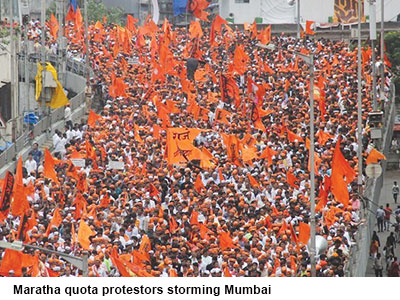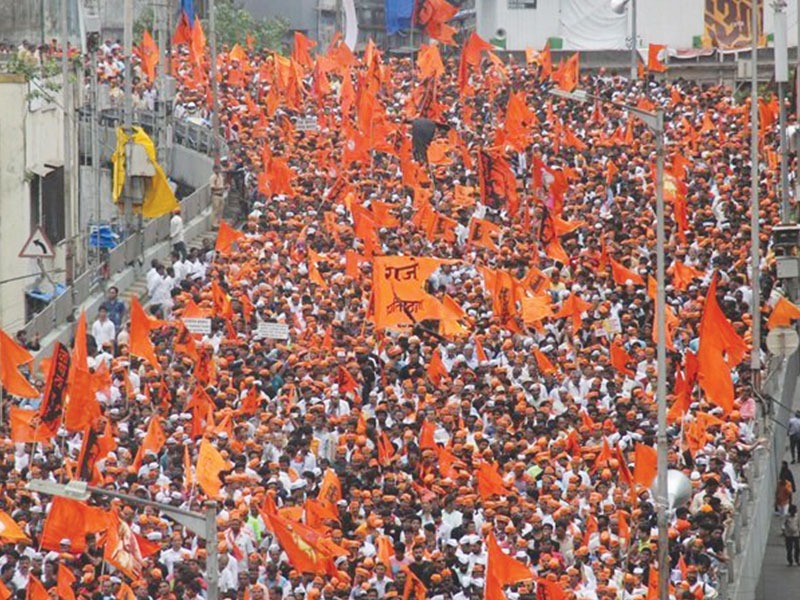– Dipta Joshi (Mumbai)
The state’s tri-party Maharashtra Vikas Aghadi (MVA) coalition government comprising the Shiv Sena, Indian National Congress (INC) and the Nationalist Congress Party (NCP), suffered a major setback on September 9 with the Supreme Court staying the state government’s Socially and Educationally Backward Classes (SEBC) Act, 2018. The Act provides 12 and 13 percent reservation quotas for the Maratha community (who constitute 32 percent of the state’s population of 115 million) in government jobs and education institutions. Hearing five petitions filed against the constitutional validity of the Act, a three-judge bench of the apex court stayed the Act and referred the case to an 11-judge constitution bench. Annoyed about the MVA government’s inability to vacate the stay, Maratha organisations across the state have been protesting since September 27, threatening to intensify their protests.
Quotas for Marathas who classify themselves as a backward caste/ community has been a long-standing issue in the state with successive governments making a reserved quota for the community a standard electoral promise. However, neither the Mandal Commission (1980) nor other commissions set up by the Maharashtra government have identified Marathas as a socially or educationally backward community/class perhaps because ten of the state’s 18 chief ministers since the state’s formation in 1960, have been Marathas and the community controls the state’s sugar, milk, cooperative banks and numerous private education institutions.
The previous Bharatiya Janata Party-Shiv Sena (BJP-Shiv Sena) coalition government was finally inspired to carve out a reserved quota for Marathas following the report of an 11-member Justice M.G. Gaikwad Committee, submitted in 2018, which states that the community’s creamy layer apart, 37 percent of Marathas live below the poverty line and 93 percent of Maratha households earn less than Rs.1 lakh per year. Therefore, the committee recommended 12 percent reservation in government colleges/ universities and 13 percent in government jobs for Marathas.
It’s pertinent to note the SEBC Act was enacted by the previous BJP-Shiv Sena government which ruled the state from 2014-19 after members of the traditionally militant Maratha community went on a state-wide rampage that resulted in 40 deaths. This prompted the previous administration to introduce the Act which mandated a 16 percent quota for the community in public higher education institutions and government employment. On June 27, 2019 the Bombay high court upheld the Act but trimmed the quotas to 12 percent in education and 13 percent in government jobs as recommended by the Gaikwad Committee.
However, following judicial sanction of the 12 percent quota for Marathas in education institutions, total reservations in higher education institutions has risen to 75 percent after taking into consideration quota for scheduled castes (15 percent), scheduled tribes (7.5 percent), other backward castes (27 percent) and nomadic tribes (2.5). Another ten percent quota was reserved countrywide by the Central government’s Economically Weaker Section Reservation Act, 2019, in January 2019 applicable to all states.
These quotas when added up are far in excess of the 50 percent ceiling for all reserved quotas imposed by the Supreme Court in Indira Sawhney’s Case (1993). However, this ceiling has been breached by several southern state governments notably Tamil Nadu, where reserved quota students fill 69 percent capacity in public higher education institutions. Legislation breaching the ceiling imposed by the Supreme Court has been parked in the Ninth Schedule which is beyond judicial purview. In effect, the Maratha community’s demand is for Ninth Schedule status for the SEBC Act. And with Marathas totalling 32 percent of the population of Maharashtra, the struggling MVA coalition government has little option but to support the community’s demand.
With reserved quota students set lower marks thresholds in entrance exams of public universities, even if the cause of social justice is served, academic standards take a beating. Therefore, it’s hardly a wonder that none of India’s 1,000 universities — some of them of 150 years vintage — is ranked among the Top 200 in highly respected World University Rankings of the London-based agencies QS and Times Higher Education. Against this, six Chinese universities in which admissions are entirely merit based, are ranked among the QS Top 200.
Posted in Education News


























